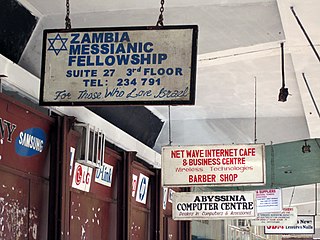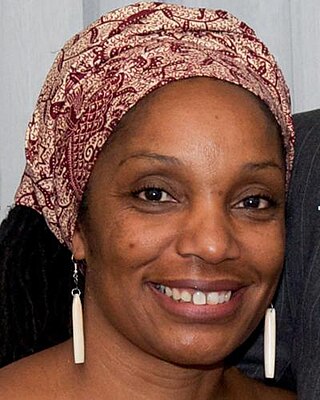Related Research Articles

Zambia, officially the Republic of Zambia, is a landlocked country at the crossroads of Central, Southern and East Africa. It is typically referred to being in South-Central Africa or Southern Africa. It is bordered to the north by the Democratic Republic of the Congo, Tanzania to the north-east, Malawi to the east, Mozambique to the southeast, Zimbabwe and Botswana to the south, Namibia to the southwest, and Angola to the west. The capital city of Zambia is Lusaka, located in the south-central part of Zambia. The population is concentrated mainly around Lusaka in the south and the Copperbelt Province to the north, the core economic hubs of the country.

The music of Zambia has a rich heritage which falls roughly into categories of traditional, popular and Christian music.

Shadow play, also known as shadow puppetry, is an ancient form of storytelling and entertainment which uses flat articulated cut-out figures which are held between a source of light and a translucent screen or scrim. The cut-out shapes of the puppets sometimes include translucent color or other types of detailing. Various effects can be achieved by moving both the puppets and the light source. A talented puppeteer can make the figures appear to walk, dance, fight, nod and laugh.

Kazembe is a traditional kingdom in modern-day Zambia, and southeastern Congo. For more than 250 years, Kazembe has been an influential kingdom of the Kiluba-Chibemba, speaking the language of the Eastern Luba-Lunda people of south-central Africa. Its position on trade routes in a well-watered, relatively fertile and well-populated area of forestry, fishery and agricultural resources drew expeditions by traders and explorers who called it variously Kasembe, Cazembe and Casembe.

Yoruba literature is the spoken and written literature of the Yoruba people, one of the largest ethno-linguistic groups in Nigeria and the rest of Africa. The Yoruba language is spoken in Nigeria, Benin, and Togo, as well as in dispersed Yoruba communities throughout the world.

Sam Ukala (1948–2021) was described as a 'great literary icon'. He was a Nigerian playwright, poet, short story writer, actor, theatre director, film producer and academic.

Zambia has several major indigenous languages, all members of the Bantu family, as well as Khwedam, Zambian Sign Language, several immigrant languages and the pidgins Settla and Fanagalo. English is the official language and the major language of business and education.
Hansel Ndumbe Eyoh was a Cameroonian theatre director, critic, and playwright, and professor of Theatre Arts at the University of Yaoundé I.

Thomas P. Riccio is an American multimedia artist and academic. He received his BA from Cleveland State University in English Literature in 1978, his MFA from Boston University in 1982, and studied in the PhD program in Performance Studies at New York University from 1983 to 1984. Riccio has directed over one hundred plays at American regional theatres, off-off and off Broadway and has worked extensively in the area of indigenous and ritual performance conducting research and/or creating performances in: South Africa, Zambia, Burkina Faso, Tanzania, Kenya, Ethiopia, Europe, Russia, Siberia, Korea, India, Nepal, China, and Alaska. In 1993 the People's Republic of Sakha declared him a “Cultural Hero”.
Zambia, officially known as the Republic of Zambia, is a landlocked country in Southern Africa. The neighbouring countries are the Democratic Republic of the Congo to the north, Tanzania to the north-east, Malawi to the east, Mozambique, Zimbabwe, Botswana, and Namibia to the south, and Angola to the west. The capital city is Lusaka, located in the southeast of the country. The population is concentrated mainly around the capital and the Copperbelt to the northwest.
Theatre of Burkina Faso combines traditional Burkinabé performance with the colonial influences and post-colonial efforts to educate rural people to produce a distinctive national theatre. Traditional ritual ceremonies of the many ethnic groups in Burkina Faso have long involved dancing with masks. Western-style theatre became common during colonial times, heavily influenced by French theatre. With independence came a new style of theatre inspired by forum theatre aimed at educating and entertaining Burkina Faso's rural people.

Drama is the specific mode of fiction represented in performance: a play, opera, mime, ballet, etc., performed in a theatre, or on radio or television. Considered as a genre of poetry in general, the dramatic mode has been contrasted with the epic and the lyrical modes ever since Aristotle's Poetics —the earliest work of dramatic theory.

Lusaka is the capital and largest city of Zambia. It is one of the fastest-developing cities in southern Africa. Lusaka is in the southern part of the central plateau at an elevation of about 1,279 metres (4,196 ft). As of 2019, the city's population was about 3.3 million, while the urban population is estimated at 2.5 million in 2018. Lusaka is the centre of both commerce and government in Zambia and connects to the country's four main highways heading north, south, east, and west. English is the official language of the city administration, while Bemba, Tonga, Lenje, Soli, Lozi, and Nyanja are the commonly spoken street languages.
Shinpa (新派) is a modern form of theater in Japan, usually featuring melodramatic stories, contrasted with the more traditional kabuki style. Taking its start in the 1880s, it later spread to cinema.
The following is a timeline of the history of the city of Lusaka, Zambia.

Mulenga Mpundu Kapwepwe is a distinguished Zambian author and social activist. Kapwepwe has garnered widespread recognition for her remarkable contributions in the field of women's history, having co-founded the Zambian Women's History Museum.
Nashil Pichen Kazembe (1932–1991) was a Zambian singer from Kaputa District in the Luapula Valley, who gained prominence in the 1970s. He spent a large part of his life in Nairobi, Kenya, where he collaborated with fellow Zambia emigre Peter Tsotsi and Benson Simbeye. As members of Eagles Lupopo Band they sang 'patriotic songs' praising President Kenneth Kaunda and commenting on various social issues.
Cinema of Zambia refers to the cinema and film industry of the country of Zambia.

Igbo literature encompasses both oral and written works of fiction and nonfiction created by the Igbo people in the Igbo language. This literary tradition reflects the cultural heritage, history, and linguistic diversity of the Igbo community. The roots of Igbo literature trace back to ancient oral traditions that included chants, folk songs, narrative poetry, and storytelling. These oral narratives were frequently recited during rituals, childbirth ceremonies, and gatherings. Proverbs and riddles were also used to convey wisdom and entertain children.
References
- Chilala, Cheela F K (2011). "The African Narrative Tale as a Tool of Education". In Schonmann, Shifra (ed.). Key Concepts in Theatre/Drama Education. Sense Publishers. ISBN 9789460913327.
- Diakhate, Ousmane (2013). "Zambia". World Encyclopedia of Contemporary Theatre: Africa. Routledge. ISBN 9781136359491.
- Banham, Martin, ed. (1995). "Zambia". The Cambridge Guide to Theatre. Cambridge.
- Banham, Martin; Hill, Errol; Woodyard, George, eds. (1994). "Zambia". The Cambridge Guide to African and Caribbean Theatre. Cambridge. ISBN 0521411394.
- Gomla, Victor N. (2012). Mobilizing the Hordes: Radio Drama as Development Theatre in Sub-Saharan Africa. Langaa Research and Publishing Group.
- Kerr, David (2004). "Southern Africa". In Banham, Martin (ed.). A History of Theatre in Africa. Cambridge University Press.
- Kerr, David (1995). African Popular Theatre: From Pre-colonial Times to the Present Day . James Currey Publishers. ISBN 0852555342.
- Taylor, Scott D. (2006). Culture and Customs of Zambia. Greenwood Publishing Group. ISBN 0313332460.
- Ebewo, Patrick (2001). "Satire and the Performing Arts: The African Heritage". In Losambe, Lokangaka; Sarinjeive, Devi (eds.). Pre-colonial and Post-colonial Drama and Theatre in Africa. New Africa Library. ISBN 9781919876061.